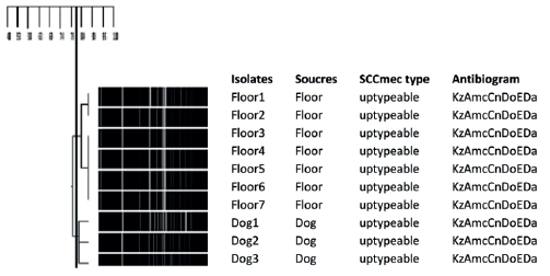Introduction
Methicillin-resistant Staphylococcus pseudintermedius (MRSP) has been increasingly concerned as causing nosocomial infection in veterinary hospitals. Generally, this pathogen acted as commensal and opportunistic pathogen in human and animal and prolonged colonization in the environment. Thus, investigation of this bacterium in the veterinary hospital must be requested for controlling the distribution in the veterinary hospital.
Objectives
To investigate the distribution of MRSP at a small animal hospital, faculty of Veterinary Science, Chulalongkorn University.
Methods
A total of 228 samples had received from 188 surfaces, nasal carriage of 13 dog patients and 26 veterinarians since 2013. MRSP were classified and confirmed by biochemical assay, multiplex-PCR, antimicrobial susceptibility and mecA gene. The correlation and virulence of MRSP clones was demonstrated by antibiogram, SCC and pulsed-field gel electrophoresis (PFGE) pattern.
Results
Thirty-six MRSP were isolated from the veterinary teaching hospital (VTH). A total of MRSP isolates on surfaces, dogs and humans were 21, 14, and 1, respectively. Thirteen of thirty-six isolates had the same antibiogram pattern associated with untypeable SCC. With clonal analysis, PFGE patterns showed close-related between MRSP on the floor surfaces and dog patients (similarity > 80%) (Figure 1) while human clones performed the difference of antibiogram and PFGE patterns.
Conclusions
Distribution of MRSP was performed on all surfaces, dogs and human. The occurrence of MRSP on the surfaces was directly related to sanitary management. With the strictly cleaning management, the nosocomial infection causing of this pathogen can be controlled.
| Figure 1 | 
Pulsed-field gel electrophoresis (PFGE), SCCmec type and antibiograms of the close correlation MRSP clones on floors and dogs. |
|
| |